This section has a set of suggestions of routes that have been enjoyed by our visitors in the past. Come with us and find the "Hidden Charm" of Vietnam. This page takes you on:
A Grand Tour of the Northern Provinces
This page describes a grand trip of 17 days around the variety of scenic attractions that are to be found in the northern Provinces of Vietnam. We offer this as a way of introducing you to this whole northern area. But as with all these suggested tours, the route is entirely up to you, as is the timing - go or stay as you please.
May 2016
- Visit Vietnam's largest waterfalls
- Stay in the old French Hill Station of Sa Pa
- Visit the spectacular Ma Li Peng Pass
- Shop at the famous Bac Ha market on Sunday
- Spend a day by the Lake in Ba Be National Park
This Grand Tour takes you on a survey of the whole of northern Vietnam from Dien Bien Phu by Laos in the north west, to the Ban Gioc waterfalls of the far north east. 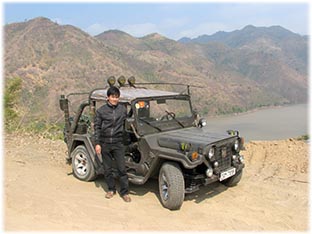 Itineraries are difficult in Vietnam for while there is no more risk involved than there would be in remoter parts of the UK, there are Oriental 'unpredictabilities': delays, roads closed, paper work not forthcoming or facilities withdrawn, that we are less used to in the West. So we do not promise any item on a schedule: only that overall you will meet probably the most delightful people in the world and see some of its most beautiful country.
Itineraries are difficult in Vietnam for while there is no more risk involved than there would be in remoter parts of the UK, there are Oriental 'unpredictabilities': delays, roads closed, paper work not forthcoming or facilities withdrawn, that we are less used to in the West. So we do not promise any item on a schedule: only that overall you will meet probably the most delightful people in the world and see some of its most beautiful country. 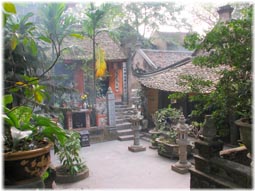 We take you where town cars cannot go, we think a Jeep lets you stay in touch with the country and people while smoothing out often appalling roads, (but modern 4 wheel drive vehicles are available if you prefer). Motor bikes may be more fun, but on the mud, on rocks, in the rain...?!
We take you where town cars cannot go, we think a Jeep lets you stay in touch with the country and people while smoothing out often appalling roads, (but modern 4 wheel drive vehicles are available if you prefer). Motor bikes may be more fun, but on the mud, on rocks, in the rain...?!
Day One. Picking you up from the airport, or your hotel, we travel west from Ha Noi pausing at the fine Thay Pagoda before heading up to Mai Chau. Here you can sleep in a traditional stilt house, 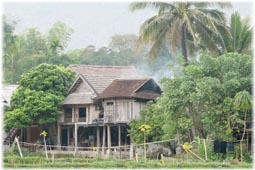 meet the ethnic White Thai people, and enjoy their dancing and music - with rice wine.
meet the ethnic White Thai people, and enjoy their dancing and music - with rice wine.
Day Two. Maybe a cycle around the fields of this farming village before you leave for the hills and the sight of tea plantations with some of Vietnam's best tea. 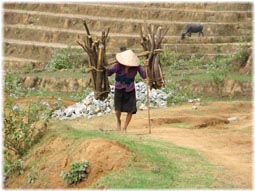 The surrounding area is home to several ethnic minorities: Green H`mong, Dzao, Thai, Muong. A night in Son La.
The surrounding area is home to several ethnic minorities: Green H`mong, Dzao, Thai, Muong. A night in Son La.
Day Three. A visit to the old French prison and the museum of the colonial days, a bath in the hot springs and some bitter bamboo shoots, grilled free-range chicken and sticky-rice cooked in bamboo to eat. Then on to a browse in Thuan Chau market passing the stream of women, in their hill-tribe clothes, walking or cycling to the market. And from there to Dien Bien Phu for the night.
Then on to a browse in Thuan Chau market passing the stream of women, in their hill-tribe clothes, walking or cycling to the market. And from there to Dien Bien Phu for the night.
Day Four. This town was made famous by the final rout of the occupying French forces by the Viet Minh on 7th May 1954:  a defeat which signalled the end of the French Indochina Empire. We can visit remnants of the famous battle before passing through forests to the valley where we stay in Muong Lay among spectacular mountains by the Da River.
a defeat which signalled the end of the French Indochina Empire. We can visit remnants of the famous battle before passing through forests to the valley where we stay in Muong Lay among spectacular mountains by the Da River.
Day Five. The highlight of this day is the view of the mountains around the Tram Ton Pass (1,900 metres) and the magnificent sight of mainland south east Asia's highest mountain: Phang Xi Pang ('Fansipan' - 3,143 metres). 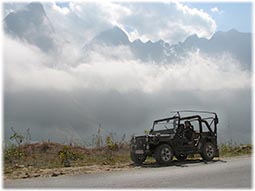 Who says you can't see air! Here two weather fronts often collide producing spectacular cloud formations. Then over to Sa Pa for the next night.
Who says you can't see air! Here two weather fronts often collide producing spectacular cloud formations. Then over to Sa Pa for the next night.
Day Six. 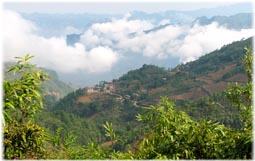 A day in Sa Pa which is famous for its terraced fields and the many H`mong and Dzao people that live in the surrounding hills. You can walk to their villages and explore the steep market lined lanes that make up this delightful hill town used by the French as a retreat from the heat in the planes below.
A day in Sa Pa which is famous for its terraced fields and the many H`mong and Dzao people that live in the surrounding hills. You can walk to their villages and explore the steep market lined lanes that make up this delightful hill town used by the French as a retreat from the heat in the planes below.
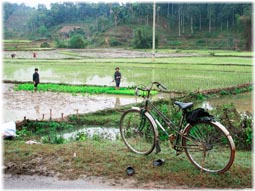 Day Seven. From Sa Pa we drop down, and down, and down, to Lao Cai a large town on the Vietnam-China border. It was razed in the Chinese invasion of 1979, hence the many new buildings.
Day Seven. From Sa Pa we drop down, and down, and down, to Lao Cai a large town on the Vietnam-China border. It was razed in the Chinese invasion of 1979, hence the many new buildings. 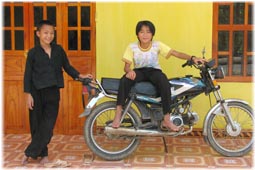 Up from here to the small highland town of Bac Ha for a night. It is famous for its huge Sunday market attracting traders from far and wide: Flower H`mong, Day, Dzao, Lai Chi, Lolo, Nhang, Nung, Thulao, Tai, Phu Lao, Chinese and, of course, Vietnamese. The local women trade and gossip, while the men consume quantities of rice wine.
Up from here to the small highland town of Bac Ha for a night. It is famous for its huge Sunday market attracting traders from far and wide: Flower H`mong, Day, Dzao, Lai Chi, Lolo, Nhang, Nung, Thulao, Tai, Phu Lao, Chinese and, of course, Vietnamese. The local women trade and gossip, while the men consume quantities of rice wine.

Day Eight. On eastwards by the small Lung Phin market and then up through the clouds to the sky and to Xin Man. Here you need our Jeep (or a modern equivalent) for cars cannot come this way and motor bikes rarely stay upright! Then we follow the Chay River through tea plantations in the winding valley to Ha Giang.
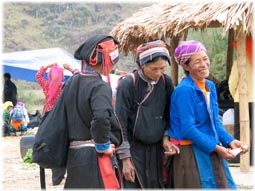 Day Nine. From the Provincial capital of Ha Giang we follow the valley of the River Gam round to Bao Lac. Sometimes we are able to make a detour up through the spectacular country at the far northern tip of Vietnam where we stay in Dong Van and then follow the Ma Phi Leng Pass with the road clinging high above of Nho Que River cut into the vertiginous mountain slopes.
Day Nine. From the Provincial capital of Ha Giang we follow the valley of the River Gam round to Bao Lac. Sometimes we are able to make a detour up through the spectacular country at the far northern tip of Vietnam where we stay in Dong Van and then follow the Ma Phi Leng Pass with the road clinging high above of Nho Que River cut into the vertiginous mountain slopes.  That new road is good, but as we approach Bao Lac, for a night in a Government Guest House, you will again be so glad of our Jeep!
That new road is good, but as we approach Bao Lac, for a night in a Government Guest House, you will again be so glad of our Jeep!
Day Ten/Eleven. This day lets you savour the meandering road through the farmlands of this north eastern area, maybe a walk by fields and rivers before reaching the Provincial capital: Cao Bang.
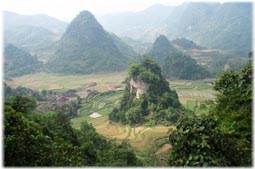
Day Eleven/Twelve. Now we may take you on an extra trip through Mung ethnic villages and a visit to the Pac Bo Cave from which Ho Chi Minh led the offensive against the French.
Day Thirteen. An excursion to the far north east of the Province and the beautiful cascades of the Ban Gioc waterfalls, the biggest in Vietnam, after which we return through the fascinating towers of a karst landscape to Cao Bang.
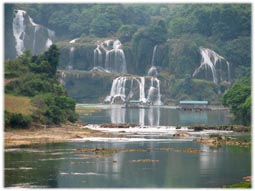
Day Fourteen. Down to Ba Be National Park through typical northern Vietnamese countryside; watching paddy field landscapes, eating at local cafes, and meeting people along the way.
Day Fifteen. A day spent based in a house on the lake side. A trip around the lake, a visit to the bat caves, and to the Dau Dang waterfall with a swim in the lake's warm waters.
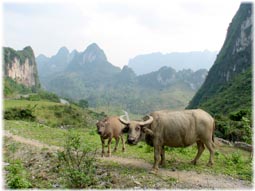
Day Sixteen. The road from Ba Be south takes us through the homely tea plantations of the Viet Bac country. This was the 'Safe Area' or ATK, from which the country was administered in the early 1940s before the first French defeat. Here we stay in the newly opened complex beside the commemorative temple to Ho Chi Minh.
Day Seventeen. 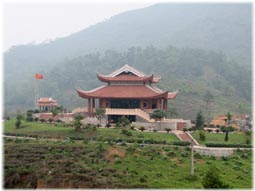 Exploring some of the many exhibitions and memorials that help the modern visitor glimpse something of the struggles that Vietnamese people have had with Westerners in the 20th century.
Then return to Ha Noi where we settle you into a comfortable hotel ready for your next excursion with Jade Monkey or the return home.
Exploring some of the many exhibitions and memorials that help the modern visitor glimpse something of the struggles that Vietnamese people have had with Westerners in the 20th century.
Then return to Ha Noi where we settle you into a comfortable hotel ready for your next excursion with Jade Monkey or the return home.
- Open Jeep for two or three passengers
- Jeep fully covered in bad weather
- English speaking driver
- Please note some of these areas are closed to foreigners on unpredictable occasions
- Add extra an extra excursion after the return by going out to Ha Long Bay